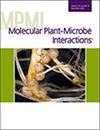Eriko Tanaka, Daisuke Umeki, Shota Kido, Rikako Makishima, Yuko Tamaki, Takumi Murakami, Masayuki Fujiwara, Yusuke Saijo
求助PDF
{"title":"利用番茄植株相关菌群防治青枯病的研究。","authors":"Eriko Tanaka, Daisuke Umeki, Shota Kido, Rikako Makishima, Yuko Tamaki, Takumi Murakami, Masayuki Fujiwara, Yusuke Saijo","doi":"10.1094/MPMI-09-24-0114-R","DOIUrl":null,"url":null,"abstract":"<p><p>Host-protective or disease-suppressive microorganisms are emerging as sustainable solutions for controlling crop diseases, such as bacterial wilt. However, the efficacy of biocontrol strategies is often constrained by limited resilience under varying environmental conditions and interactions with native microbial communities in the field. One major challenge is that introduced biocontrol microbes often face suppression by indigenous microbes due to competitive interactions. Synthetic communities (SynComs) offer a promising alternative strategy. However, conventional approaches to assembling SynComs by combining different microbial isolates often result in antagonism and competition among strains, leading to ineffective and inconsistent outcomes. In this study, we assembled a bacterial wilt-suppressive SynCom for tomato, composed of bacterial isolates derived from co-cultured microbial complexes associated with healthy plants. This SynCom demonstrates significant disease-suppressive effects against <i>Ralstonia pseudosolanacearum</i> in tomato seedlings under both axenic and soil conditions. Additionally, our findings suggest the presence of an optimal SynCom colonization level in plants, which is crucial for effective disease suppression. The SynCom also exhibits direct antibiotic activity and modulates the plant-associated microbiome. Our results provide an effective approach to constructing SynComs with consistent and effective disease-suppressive properties within microbial community contexts. [Formula: see text] Copyright © 2025 The Author(s). This is an open access article distributed under the CC BY-NC-ND 4.0 International license.</p>","PeriodicalId":19009,"journal":{"name":"Molecular Plant-microbe Interactions","volume":" ","pages":"411-426"},"PeriodicalIF":3.4000,"publicationDate":"2025-05-01","publicationTypes":"Journal Article","fieldsOfStudy":null,"isOpenAccess":false,"openAccessPdf":"","citationCount":"0","resultStr":"{\"title\":\"Biocontrol of Bacterial Wilt Disease Using Plant-Associated Bacterial Communities in Tomato.\",\"authors\":\"Eriko Tanaka, Daisuke Umeki, Shota Kido, Rikako Makishima, Yuko Tamaki, Takumi Murakami, Masayuki Fujiwara, Yusuke Saijo\",\"doi\":\"10.1094/MPMI-09-24-0114-R\",\"DOIUrl\":null,\"url\":null,\"abstract\":\"<p><p>Host-protective or disease-suppressive microorganisms are emerging as sustainable solutions for controlling crop diseases, such as bacterial wilt. However, the efficacy of biocontrol strategies is often constrained by limited resilience under varying environmental conditions and interactions with native microbial communities in the field. One major challenge is that introduced biocontrol microbes often face suppression by indigenous microbes due to competitive interactions. Synthetic communities (SynComs) offer a promising alternative strategy. However, conventional approaches to assembling SynComs by combining different microbial isolates often result in antagonism and competition among strains, leading to ineffective and inconsistent outcomes. In this study, we assembled a bacterial wilt-suppressive SynCom for tomato, composed of bacterial isolates derived from co-cultured microbial complexes associated with healthy plants. This SynCom demonstrates significant disease-suppressive effects against <i>Ralstonia pseudosolanacearum</i> in tomato seedlings under both axenic and soil conditions. Additionally, our findings suggest the presence of an optimal SynCom colonization level in plants, which is crucial for effective disease suppression. The SynCom also exhibits direct antibiotic activity and modulates the plant-associated microbiome. Our results provide an effective approach to constructing SynComs with consistent and effective disease-suppressive properties within microbial community contexts. [Formula: see text] Copyright © 2025 The Author(s). This is an open access article distributed under the CC BY-NC-ND 4.0 International license.</p>\",\"PeriodicalId\":19009,\"journal\":{\"name\":\"Molecular Plant-microbe Interactions\",\"volume\":\" \",\"pages\":\"411-426\"},\"PeriodicalIF\":3.4000,\"publicationDate\":\"2025-05-01\",\"publicationTypes\":\"Journal Article\",\"fieldsOfStudy\":null,\"isOpenAccess\":false,\"openAccessPdf\":\"\",\"citationCount\":\"0\",\"resultStr\":null,\"platform\":\"Semanticscholar\",\"paperid\":null,\"PeriodicalName\":\"Molecular Plant-microbe Interactions\",\"FirstCategoryId\":\"99\",\"ListUrlMain\":\"https://doi.org/10.1094/MPMI-09-24-0114-R\",\"RegionNum\":3,\"RegionCategory\":\"生物学\",\"ArticlePicture\":[],\"TitleCN\":null,\"AbstractTextCN\":null,\"PMCID\":null,\"EPubDate\":\"2025/5/12 0:00:00\",\"PubModel\":\"Epub\",\"JCR\":\"Q2\",\"JCRName\":\"BIOCHEMISTRY & MOLECULAR BIOLOGY\",\"Score\":null,\"Total\":0}","platform":"Semanticscholar","paperid":null,"PeriodicalName":"Molecular Plant-microbe Interactions","FirstCategoryId":"99","ListUrlMain":"https://doi.org/10.1094/MPMI-09-24-0114-R","RegionNum":3,"RegionCategory":"生物学","ArticlePicture":[],"TitleCN":null,"AbstractTextCN":null,"PMCID":null,"EPubDate":"2025/5/12 0:00:00","PubModel":"Epub","JCR":"Q2","JCRName":"BIOCHEMISTRY & MOLECULAR BIOLOGY","Score":null,"Total":0}
引用次数: 0
引用
批量引用

 求助内容:
求助内容: 应助结果提醒方式:
应助结果提醒方式:


